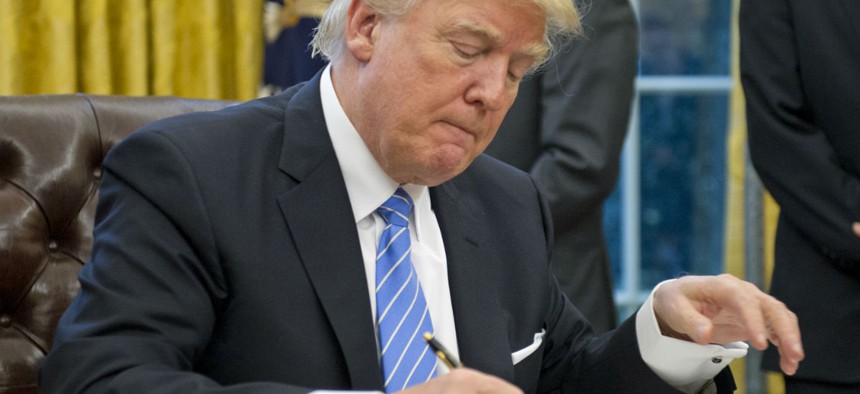
President Trump signs orders including the hiring freeze on Monday. Ron Sachs / Pool via CNP /MediaPunch/IPX
Internal Promotions, Postal Service and CIA Among Trump's Hiring Freeze Exemptions
Agency leaders told follow shutdown guidance for "national security and public safety" exemptions.
A slew of positions are now exempt from President Trump’s governmentwide hiring freeze, according to new guidance from the Office of Management and Budget and the Office of Personnel Management.
In the second piece of guidance obtained by Government Executive since Trump signed the presidential memorandum last week ordering the freeze, Mark Sandy and Kathleen McGettigan, the respective acting OMB and OPM directors, spelled out in significant detail what exemptions the administration will permit. Trump’s memo initially said only positions in “national security and public safety” -- as well as those determined to be necessary by the OPM director -- would be free from the moratorium, though agencies have since interpreted that to include public health and other areas.
Sandy and McGettigan said “national security” positions include foreign relations responsibilities, while public safety includes “essential activities to the extent that they protect life and property.” The acting directors referred agency heads to OMB’s guidance for determining exemptions during a government shutdown for further clarification. They instructed agency leaders to consult with their chief human capital officers and counsel offices, as well as OPM and OMB, when making determinations. Inspectors general are considered agency leaders for the sake of the guidance.
In addition to those general exemptions, OPM and OMB laid out specific exceptions.
As Trump noted during his signing of the memorandum, all military personnel are exempt from the freeze. That includes all uniformed officials, including the Coast Guard, Commissioned Corps of the U.S. Public Health Service, and the Commissioned Officer Corps of the National Oceanic and Atmospheric Administration.
All political positions, including Schedule C appointments and non-career Senior Executive Service vacancies, are exempted. Agencies can fill temporary and seasonal vacancies as necessary to meet “traditionally recurring season workloads,” though they must keep OMB’s Resource Management Office informed. Areas in which Congress has required hiring by law are also exempted from the freeze.
Some agencies have been exempted altogether: positions at the U.S. Postal Service, CIA and Office of the Director of National Intelligence are all exempt. USPS had said it was exempt in previous hiring freezes but was seeking further clarification from the White House.
“Internal career ladder promotions” are not subject to the freeze, nor are appointments made under the Pathways and Presidential Management Fellows programs. Employees onboarded as part of industry exchange programs are exempted so long as the workers hired under that authority do not exceed the total from before the freeze went into place.
Employees detailed between agencies are not affected so long as reimbursements are not being used to “circumvent the intent of the freeze.” Reallocations of current employees within an agency are allowable if they are used to “meet the highest priority needs” such as national security and essential services. Agencies can also accept voluntary transfers of current SES between agencies to “secure the leadership capacity,” subject to OPM approval. Sandy and McGettigan reminded agencies of Trump’s mandate that contractors may not be used to skirt the freeze.
“For example, agencies shall not acquire by contract with a commercial vendor services that are substantially similar to those that would have been provided by a federal civilian in a vacancy covered by the [presidential memorandum],” Sandy and McGettigan wrote. Normal contract operations may continue, the acting directors added.
In immediate guidance after Trump’s memo, Sandy said employees with an offer in hand as of Jan. 22 and a start date of Feb. 22 or prior should report to work on the agreed-to date. He told agency directors to determine whether job offers should stand for those who had an offer as of Jan. 22, but did not have a first day established or it was determined to be after Feb. 22. The OMB and OPM directors have until April 22 to submit a long-term attrition plan to reduce the size of the federal workforce. The freeze will expire upon the implementation of that plan.
The updated guidance comes as members of Congress and individual agencies have sought further clarification on how the freeze would apply to their constituents and employees, respectively. Some agencies, such as the Defense Department, have promised a more detailed list of exemptions in the near future.
If agency heads would like additional exemptions, they can write to the OPM director to make the request. The leaders must explain the critical need and why reallocation of staff is not possible.
Read the full guidance here.







